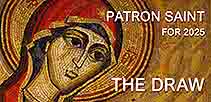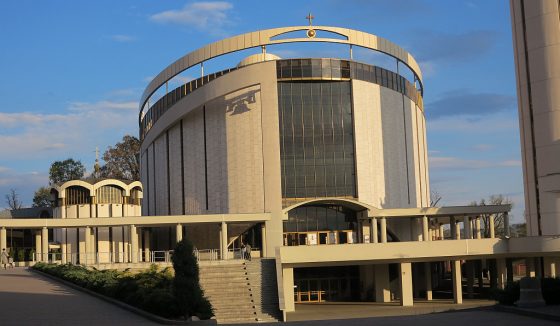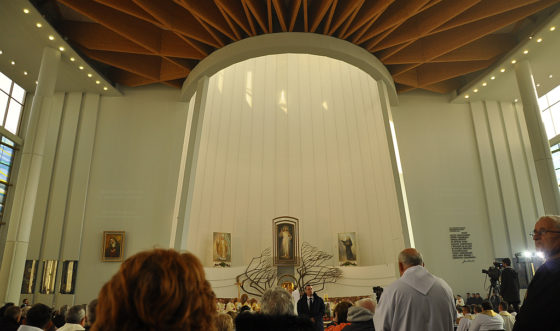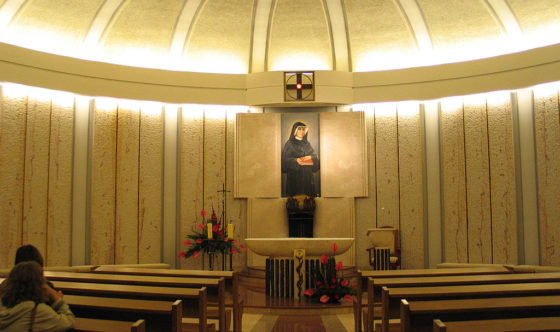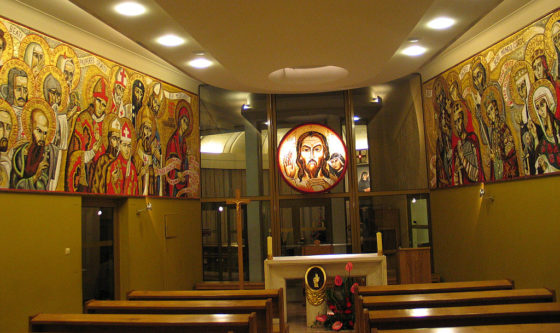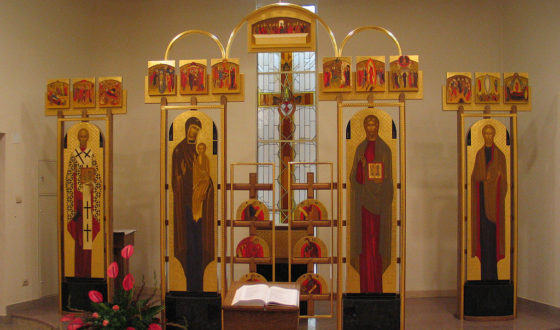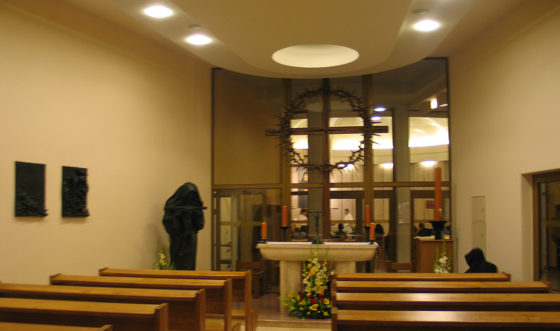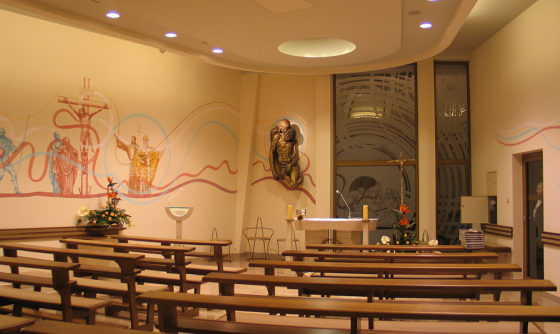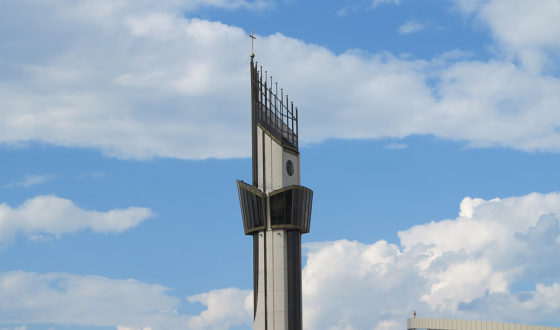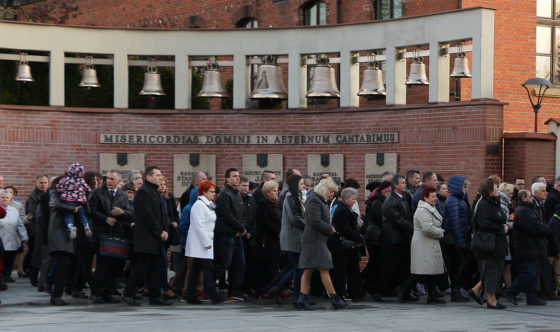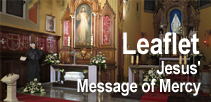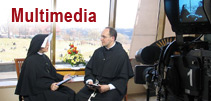In 1966, following Sister Faustina’s beatification, the rapid growth of the devotion to the Divine Mercy and the crowds of pilgrimages coming to the Łagiewniki Shrine, Cardinal Franciszek Macharski, Metropolitan Archbishop of Kraków, after the of Sister Faustina, established a foundation to build a new church to accommodate a congregation of 5 thousand, together with facilities for pilgrims. On 7 June 1997, during his visit to Łagiewniki, the Holy Father John Paul II consecrated the cornerstone brought from Calvary for the construction of the new church. He viewed a mock-up of the project and endorsed it with his signature. On 17 August 2002, during his last pilgrimage to Poland, he consecrated the new church and entrusted the whole world to the Divine Mercy. Since 6 March 2003 the church has enjoyed the status of a Minor Basilica.
Designed by Witold Cęckiewicz, the basilica resembles a ship, a modern Ark of the Covenant for the salvation of all who put their trust in Divine mercy. A large stone altar stands in the chancel, and behind it there is a tabernacle in the shape of a sphere representing the world with all the continents, surrounded by a huge, wind-swept shrub symbolising the modern world and Man assailed by a variety of forces. The shrub over the tabernacle serves as a sort of framework for a picture of the Merciful Jesus (by Jan Chrząszcz) reminding that “in God’s mercy the world will find peace, and Man happiness,” as John Paul II said. Some people see the sanctuary interior as a symbolic representation of the burning bush from which God spoke to Moses. As God spoke to Moses in the past, so in our times God has spoken through St. Faustina, proclaiming the prophetic message of Mercy for the Church and the world.
On one side of the walls separating the chancel from the main nave there is a picture of Our Lady of Ostra Brama as Our Lady of Mercy (by Jan Chrząszcz), and on the other side there is a plaque with the text of the Pope’s act of entrustment of the world to the Divine Mercy. The cornerstone brought from Calvary and consecrated by Pope John Paul II is in the porch at the entrance to the Basilica. Next to it there is a plaque commemorating the Pope’s second pilgrimage to Łagiewniki on 17 August 2002 and his consecration of the Basilica.
Stained glass decorations are up in the tall windows and the one over the chancel, which has a surface area of 148 square metres, is the largest stained-glass window in Kraków. It shows a huge sun with a luminous cross, the symbol of faith and the most persuasive sign of Divine mercy, superimposed on it. Below the horizon is the sea, the colours of which harmonize with the stained-glass windows at the side of the basilica. Below the horizon there is a vast sea, in a colour scheme harmonised with the stained glass in the side windows and intended to give the impression of emerging from the depths of the ocean. The stained glass was designed by Witold Cęckiewicz, the architect who designed the Basilica, and stained-glass artist Małgorzata Toborowicz.
In the lower part of the Basilica there are five beautiful chapels set in a radial arrangement. Each has an interior decoration presented as a gift from the Church of one of the European countries. The Chapel of St. Faustina is in the central position, and its interior decoration is a gift donated by the Bishops of Italy (hence its alternative name, “the Italian Chapel”). Behind the altar there is a tabernacle in the shape of a flower about to blossom, alluding to the words of St. Faustina, who wrote that God’s love is the flower, and mercy is its fruit (Diary 949). Over the tabernacle there is a picture of St. Faustina holding her Diary. The picture, by Jan Chrząszcz, is superimposed on a reredos shaped like an open book. A reliquary in the shape of a rose containing a relic of St. Faustina is mounted in front of the altar. The altar, pulpit, and the plinth of the reliquary are made of travertine in a pale shade, while the walls are overlaid with slabs of Polish sandstone. The floor has a radial pattern alluding to the arrangement in the top level of the Basilica and the rays in the picture of the Merciful Jesus, symbols of all manner of graces. The Italian Chapel is topped with a dome. The Chapel was consecrated by Cardinal Camillo Ruini, President of the Bishops’ Conference of Italy, on the centenary of St. Faustina’s baptism, 27 August 2005, the day when Cardinal Stanislaw Dziwisz, Archbishop of Kraków, made his ceremonial entry into Wawel Cathedral,
As you enter the Lower Basilica and walk towards St. Faustina’s Chapel, the Communio Sanctorum Chapel will be on the right. This Chapel was consecrated during a Hungarian pilgrimage on 9 October 2004 by Cardinal Péter Erdó, Primate of Hungary, and Cardinal Franciszek Macharski, Metropolitan Archbishop of Kraków. Its interior decoration is the gift of the Church in Hungary, and that is why it is also known as the Hungarian Chapel. Its side walls are decorated with a splendid series of mosaics depicting over 60 saints and blesseds from Hungary, Poland, and other European countries who have contributed some of the finest chapters in the history of the Church. They are grouped in separate clusters, and each cluster is inscribed with one of the Eight Beatitudes from the Sermon on the Mount, giving a commentary on their lives. This procession of saints is headed by Mary, the Mother of God. Over the marble altar there is a mosaic showing the Merciful Jesus and St. Faustina, circumscribed with the words Jesus, I trust in You in several languages. In front of the altar there is a reliquary in the shape of a right hand containing a relic of St. Stephen, Patron Saint of Hungary. The Chapel’s interior decoration was designed and made by the Hungarian artist Father László Puskás, who is a Uniate Greek Catholic priest, and his wife.
The Chapel of St. Andrew the Apostle is to the right, next to the Communio Sanctorum Chapel, and it is the gift of the Greek Catholic (Uniate) Church of Poland and Ukraine. Its iconostasis presents an icon of St. Andrew, Patron Saint of the Eastern Church, and was made by the Ukrainian artist Lubomir Medvid. The Chapel has a rich decoration of wall paintings in the Eastern tradition and depicting the history of the Church. The paintings by Timur Karim and Małgorzata Dawidiuk show the Synaxis of the Theotokos (the Gathering in Honour of the Mother of God, celebrated in the Eastern Church on the second day of Christmas), the Baptism of Rus’ (Ukraine), the Acheiropoietos Christ (the Image of Christ Not Made by Human Hand, also known as the Mandylion or the Image of Edessa), and the Elevation of the True Cross. The Chapel was consecrated on 24 June 2007 by Archbishop Jan Martyniak, Uniate Metropolitan of Przemyśl and Warsaw, and Cardinal Stanisław Dziwisz, Metropolitan Archbishop of Kraków.
The Holy Cross Chapel is on the left-hand side of the main entrance. Its interior decoration is the gift of the Diocese of Cologne, and Catholics from Germany contributed to its design, hence its alternative name, the German Chapel. Its dominant features are a tall cross entwined by a crown of thorns and the Stations of the Cross along its walls. The Cross and the stations along the route of Jesus’ Passion bespeak God’s merciful love for Man, offering its best testimonial.
The Chapel of Our Lady of the Seven Sorrows is next to the Holy Cross Chapel. The interior decoration of this Chapel is the gift of the Slovak Church, and hence it is also known as the Slovak Chapel. It was designed by the architect Marian Sitarčík, and its predominant feature is a beautiful Pieta sculpted by Jan Lesňák. The walls are decorated with frescoes depicting the Seven Sorrows of Our Lady, by Petr Čambál, and quotations from the Magnificat inscribed in Slovak, and in Old Church Slavonic, Latin, Greek, and Hebrew, the languages of the liturgy in the times of Saints Cyril and Methodius, the Apostles of the Slavs. On the wall behind the altar there is a glass panel with window graphics showing Jesus’ Entombment and His Resurrection. The Slovak Chapel was consecrated during the Slovak National Pilgrimage on 19 April 2008, by Bishop František Tondra, President of the Bishops’ Conference of Slovakia, Archbishop Ján Babjak, the Greek Catholic (Uniate) Archbishop of Prešov, and Cardinal Stanisław Dziwisz, Metropolitan Archbishop of Kraków.
In front of the Basilica there is a free-standing viewing tower which is 76 metres tall and is a landmark which can be seen from many places in the city. A viewing platform, at a height of over 40 metres, provides a panoramic view of the city and its environs, and, given good visibility, even the Tatra Mountains. In the right visibility conditions, you can even see the Tatra Mountains. A staircase of 315 steps leads up to the platform, but there is also a lift which disabled persons can use. Over the entrance to the tower there is a statue of Pope John Paul II as a pilgrim of peace holding a dove and bringing the message of Mercy to the world. The statue of the Pope, by Witold Cęckiewicz, was unveiled in 2006, on on 27 May, the day of the pilgrimage of his successor, Pope Benedict XVI, to the Łagiewniki Shrine.
In front of the basilica there is a set of 9 bells which play carillons in honour of Divine mercy. The names of the bells are Jesus, Sister Faustina, John Paul II, and the remaining six have been named after other Cracovian Saints (St. Stanislaus, St. Jacek, St. Jadwiga, St. John Cantius, St. Rafał, and St. Albert). The bells were blessed by Cardinal Stanisław Dziwisz, Archbishop of Kraków, on the Feast of Mercy in 2009.
Sr. M. Elżbieta Siepak ISMM
Translated by Orest Pawlak










